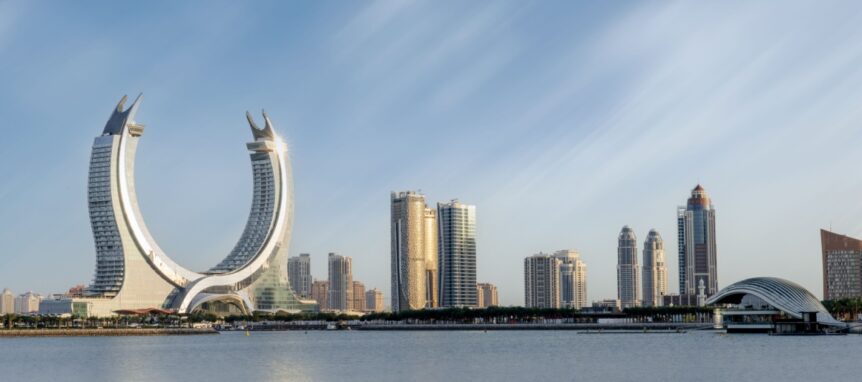In June 2025, Iran fired about a dozen missiles at Qatar’s quiet capital city, targeting a large American military base in the area.
Doha, the quiet capital of Qatar, is usually known for public safety and manicured malls. So the panicked scenes there on Monday after Iran fired more than a dozen missiles at an American military base near the city were unlike anything its residents had seen.
Smoking and blackened shrapnel fell from the sky. Interceptors that collided with the missiles and exploded midair were visible from The Pearl Island, a man-made land mass filled with high-end apartments.
Despite years of efforts to build bridges with Iran, curry favor with President Trump and establish their capitals as business-friendly havens in a volatile Middle East, they have found themselves sucked into a conflict that they have sought to avoid.
“It leaves the Gulf in a really uncomfortable spot,” said Dina Esfandiary, Middle East geoeconomics lead at Bloomberg Economics. “Their absolute worst fear came true: They were caught in the middle of an escalation between Iran and the U.S.”
America and Iran
It appears that the on-again, off-again conflict between the United States and Iran is definitely on again. How far this round goes remains to be seen.
The boxing match began in the 1970s, when, at least according to many Iranians, the Americans went to the wrong corner. U.S. support for the Western puppet and much-hated Shah of Iran bubbled over into an embassy hostage situation that lasted over a year and clearly exposed America’s weakness in the region.
But that’s all pretty much ancient history now. Now, the big news is Donald Trump’s longstanding antagonism toward Iran.
Trump 1.0 began with a travel ban and withdrawal from the Joint Comprehensive Plan of Action (JCPOA), or the “nuclear deal.” Trump tightened sanctions and Iran responded by upping its uranium enrichment program.
A major escalation followed a December 2019 rocket attack on the K-1 Air Base in Iraq, which led to American airstrikes on Iranian-backed militias and a retaliatory attack on the U.S. embassy in Baghdad. Later, the January 3, 2020, death of Iranian General Qasem Soleimani in a U.S. drone strike prompted Iranian missile attacks on U.S. bases in Iraq and heightened fears of war. The crisis deepened with the accidental downing of a Ukrainian passenger plane by Iranian forces and continued through early 2020 with retaliatory strikes and threats.
Initially, Trump’s successor, Joe Biden, tried to follow his former boss’s policy of rapprochement. But that effort fell flat, and the Trump 1.0 pattern of sanctions and defiance resumed. By late 2024, relations remained adversarial, marked by unresolved security disputes and growing mistrust.
All that brings us to Trump 2.0. Threats, sanctions, and saber-rattling escalated into armed conflict in June 2025. So, round and round we go, and where we stop, nobody knows.
America and Qatar
While all this goes on, traditional U.S. allies in the region, like Qatar, are caught in the crossfire. Many Gulf Coast Countries want to keep close ties with the world’s largest economic power and petroleum consumer, and at the same time make friends with the neighborhood bully. That is a fine line.
Qatar has a history of trying to play both sides. For example, shortly before the 2003 American invasion of Iraq, Qatar offered sanctuary to Iraqi strongman Saddam Hussein. Almost immediately thereafter, Qatar became the United States’ Central Command headquarters and one of the main launching sites of the invasion of Iraq.
In the next decade, Qatar’s royal family supported the 2011 Arab Spring rebels. Qatar joined NATO operations in Libya and reportedly armed Libyan opposition groups against Muammar Gaddafi. It also bankrolled rebel groups in the Syrian civil war against Bashar al-Assad. Several of its neighbors broke diplomatic relations with Qatar in 2017, over its alleged support of “terrorism.”
Sometimes, playing both sides pays off. Since the 2000s, Qatar has increasingly emerged on a wider foreign policy stage, especially as a mediator for Middle Eastern conflicts. Qatar mediated between the rival Palestinian factions Fatah and Hamas in 2006 and helped unite Lebanese leaders into forming a political agreement during the 2008 crisis.
More recently, it played a major role in establishing the first ceasefire in the 2023 Israel-Hamas war and the concurrent initial hostage exchange. These high-risk diplomatic middleman endeavors (and its own rigorous defense stance) have thus earned it a reputation as “a prickly Switzerland.”
Contractors in Qatar
American private military contractors often deploy to places like Qatar that want close ties with Washington but do not want to advertise that fact.
Contractors do the same jobs that regular servicemembers do, at least for the most part. But contractors aren’t U.S. troops, and except for the American flag patches on their uniforms, blend in very well with locals.
Drawing these deployments, contractors usually provide security, maintain American military facilities, and maintain the systems that countries like Qatar buy.
Security has not been a big deal in Qatar, but that may be changing. In March 2005, a suicide bomber with links to al Qaeda killed a British schoolteacher who was out for a night on the town. That incident frightened many people. The recent rocket attacks reminded citizens that, like it or not, they’re on the front line of various MENA (Middle East and North Africa) conflicts.
Heavily armed contractors on a random street corner make citizens feel safer and deter criminal activity. Who could ask for anything more?
As the American military presence remains high in the region, military facilities need constant renovation and expansion. These efforts in Qatar assist recruiting efforts at home. No one wants to live in barracks that were built during the first Persian Gulf War era.
Technical contractors have a long history in the region. Ironically, Iran was one of the first deployment sites. In the 1970s, approximately 25,000 American technicians were deployed to Iran to maintain military equipment (such as F-14s) that had been sold to the Shah’s government.
Injury Compensation Available
Construction and security jobs are among the most dangerous jobs in the world. These injuries often financially devastate families. That’s especially true if the victim is an overseas contractor. A Defense Base Act lawyer can obtain lost wage compensation as follows:
- Temporary Total Disability: Injured contractors who cannot work as they recover from deployment-related illnesses or injuries usually receive two-thirds of their average weekly wage (AWW) for the duration of their disabilities.
- Temporary Partial Disability: If a victim can work a lower-paying job, like a light-duty assignment, the Defense Base Act usually pays two-thirds of the difference between the victim’s old and new incomes.
- Permanent Total Disability: Sometimes, the illness or injury is so severe that it permanently impairs a work-related activity, such as following directions or standing. So, the DBA pays two-thirds of the victim’s projected future lost wages.
- Permanent Partial Disability: The same rules apply if a victim must permanently work part-time or light-duty jobs due to a physical, mental, or emotional deployment-related disability.
The Defense Base Act broadly defines deployment-related injury. A Defense Base Act lawyer must show a nexus (indirect connection) between deployment and injury.
Off-the-clock injuries are a good example. If John the construction worker is injured in a commuter car crash in Denver, workers’ compensation benefits are unavailable. But if John the construction contractor is hurt in a commuter car crash in Doha, he’s eligible for lost wage replacement and other benefits.
For more information about the DBA procedure, contact Barnett, Lerner, Karsen, Frankel & Castro, P.A.

